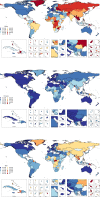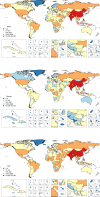The burden of unintentional drowning: global, regional and national estimates of mortality from the Global Burden of Disease 2017 Study
- PMID: 32079663
- PMCID: PMC7571364
- DOI: 10.1136/injuryprev-2019-043484
The burden of unintentional drowning: global, regional and national estimates of mortality from the Global Burden of Disease 2017 Study
Erratum in
-
Correction: The burden of unintentional drowning: Global, regional and national estimates of mortality from the Global Burden of Disease 2017 Study.Inj Prev. 2020 Oct;26(Supp 1):i166. doi: 10.1136/injuryprev-2019-043484corr1. Epub 2020 Sep 28. Inj Prev. 2020. PMID: 32989008 Free PMC article. No abstract available.
Abstract
Background: Drowning is a leading cause of injury-related mortality globally. Unintentional drowning (International Classification of Diseases (ICD) 10 codes W65-74 and ICD9 E910) is one of the 30 mutually exclusive and collectively exhaustive causes of injury-related mortality in the Global Burden of Disease (GBD) study. This study's objective is to describe unintentional drowning using GBD estimates from 1990 to 2017.
Methods: Unintentional drowning from GBD 2017 was estimated for cause-specific mortality and years of life lost (YLLs), age, sex, country, region, Socio-demographic Index (SDI) quintile, and trends from 1990 to 2017. GBD 2017 used standard GBD methods for estimating mortality from drowning.
Results: Globally, unintentional drowning mortality decreased by 44.5% between 1990 and 2017, from 531 956 (uncertainty interval (UI): 484 107 to 572 854) to 295 210 (284 493 to 306 187) deaths. Global age-standardised mortality rates decreased 57.4%, from 9.3 (8.5 to 10.0) in 1990 to 4.0 (3.8 to 4.1) per 100 000 per annum in 2017. Unintentional drowning-associated mortality was generally higher in children, males and in low-SDI to middle-SDI countries. China, India, Pakistan and Bangladesh accounted for 51.2% of all drowning deaths in 2017. Oceania was the region with the highest rate of age-standardised YLLs in 2017, with 45 434 (40 850 to 50 539) YLLs per 100 000 across both sexes.
Conclusions: There has been a decline in global drowning rates. This study shows that the decline was not consistent across countries. The results reinforce the need for continued and improved policy, prevention and research efforts, with a focus on low- and middle-income countries.
Keywords: burden of disease; drowning; global.
© Author(s) (or their employer(s)) 2020. Re-use permitted under CC BY. Published by BMJ.
Conflict of interest statement
Competing interests: Dr. Franklin reports receiving airfare reimbursement from Royal Life Saving Society - Australia, during the conduct of the study. Dr. Bhaumik reports grants from Royal National Lifeboat Institution, UK, outside the submitted work. Dr. Driscoll reports grants from World Health Organization, during the conduct of the study. Dr. Ivers reports grants from Royal National LifeBoat Institute, outside the submitted work. Dr. Khubchandani reports grants from Merck Research Laboratories, outside the submitted work. Dr. James reports grants from Sanofi Pasteur, outside the submitted work.
Figures







References
-
- World Health Organization Global report on drowning: preventing a leading killer. Geneva: World Health organization, 2014. ISBN: 978 92 4 156478 6 https://www.who.int/violence_injury_prevention/global_report_drowning/en/
-
- van Beeck EF, Branche CM, Szpilman D, et al. . A new definition of drowning: towards documentation and prevention of a global public health problem. Bull World Health Organ 2005;83:853–6. doi:/S0042-96862005001100015 - PMC - PubMed
-
- World Health Organization Preventing drowning: an implementation guide. Geneva: World Health organization, 2017. ISBN: 978-92-4-151193-3 https://www.who.int/violence_injury_prevention/drowning/drowning_prevent...
-
- Roth GA, Abate D, Abate KH, et al. . Global, regional, and national age-sex-specific mortality for 282 causes of death in 195 countries and territories, 1980-2017: a systematic analysis for the global burden of disease study 2017. Lancet 2018;392:1736–88. 10.1016/S0140-6736(18)32203-7 - DOI - PMC - PubMed
Publication types
MeSH terms
Grants and funding
LinkOut - more resources
Full Text Sources
Medical
